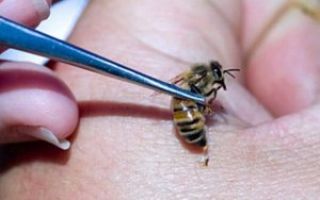Content
- 1 Composition of bee venom
- 2 Why is a bee sting useful?
- 3 Bee sting harm
- 4 Bee sting signs
- 5 First aid to the victim with a bee sting
- 6 Folk remedies for a bee sting
- 7 Bee sting allergy
- 8 How to avoid a bee sting
- 9 The use of bee venom in medicine
- 10 Bee venom treatment
- 11 Bee venom in cosmetology
- 12 Contraindications to bee venom treatment
- 13 Conclusion
The benefits and harms of bee venom have a fragile line between themselves. The sting of an insect at the time of the bite digs deep into the skin. Due to muscle contractions, the released apitoxin rapidly enters the circulatory system. The body's response to a bite can be completely ambiguous. Bee venom affects each person in different ways, although mainly single insect bites exhibit extremely beneficial health properties.
Composition of bee venom
Bee venom is produced by secretion of glands in honey bees. The substance has a slightly yellow liquid consistency, with a pungent aroma and bitter taste.
Before you find out what the benefits and harms of bee stings are, you should familiarize yourself with its chemical composition. All components of apitoxin have individual characteristics, simultaneously enhancing its overall effect in a complex. The main elements of bee venom are:
- melitin - possesses powerful antibacterial, antiviral, anti-inflammatory properties, as well as nonspecific cytotoxicity and hemolytic properties;
- apamine - a substance with neurotropic action, increases the activity of nerve receptors;
- histamine - an organic compound that provokes the development of an allergic reaction, a regulator of important physiological processes in the body;
- hyaluronidase - a group of enzymes that increase the permeability of tissues, preventing the growth of cancer cells;
- phospholipase - helps to accelerate the hydrolysis of phospholipids.
Bee venom contains some beneficial chemicals. Among them:
- magnesium;
- formic acid;
- phosphorus;
- carbohydrates;
- sulfur;
- proteins;
- polypeptides.
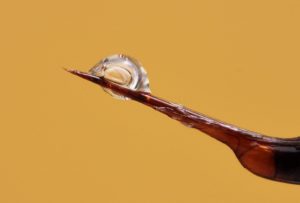
Why is a bee sting useful?
Scientists in the field of medicine confirm that the benefits of bee venom for humans are quite large. The substance is distinguished by its specific healing properties. These include:
- restoration of tissue structures of bones;
- normalization of the heart rate;
- analgesic, antispasmodic, antiviral action;
- increasing the amount of serotonin;
- beneficial effects on blood vessels, lowering cholesterol levels;
- cleansing the blood;
- improving the functioning of the digestive system;
- getting rid of pathogenic microbes;
- activation of the body's immune forces.
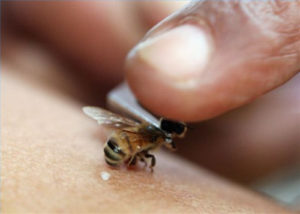
Bee sting harm
The benefits of a bee sting for medicinal purposes for humans is an indisputable fact. Despite this, there is a risk of harm to health in varying degrees of severity. With a single case of a bee sting, a local reaction occurs, characterizing the occurrence of severe pain and burning sensations.If an allergy to the secreted poison in a mild form is added to the usual symptoms, urticaria occurs on the affected area of the skin, accompanied by itching and blisters.
A reaction to a bee sting can to a greater extent provoke Quincke's edema, in which the swelling spreads to the face, neck, as well as eyelids, tongue, larynx. The condition is aggravated by the accompaniment of various negative symptoms. Among them:
- hoarseness of voice;
- dry, barking cough;
- feeling of suffocation;
- breathing disorder;
- nausea, vomiting;
- severe abdominal cramps;
- hypoxic coma;
- death.
The onset of anaphylactic shock is no less a health and life-threatening complication with a bee sting. In this case, there is an acute decrease in blood circulation, a sharp drop in blood pressure, collapse, fainting.
Bee sting signs
A bee sting is distinguished by the specificity of the process with an instant response of the affected person's body. There are certain signs:
- a released sting that digs into the skin with the help of notches;
- redness and swelling of the affected area of the body;
- sudden severe pain at the bite point;
- severe swelling;
- manifestations of an allergic reaction to varying degrees;
- the insect that releases the sting dies.
The unpleasant symptoms subside after the bee sting is removed from the body, and the effect of the poison continues for some time.
First aid to the victim with a bee sting
A bee sting requires the immediate implementation of a number of specific actions:
- remove the sting from the victim's skin as quickly as possible, since from it the poisonous substance enters the blood;
- treat with an antiseptic;
- apply ice or cold compress;
- to relieve swelling, use anti-inflammatory hormonal ointments;
- in order to avoid increasing the toxic effect, do not drink hot drinks;
- take antihistamines.
In the event of a severe allergic reaction to a bee sting, it is recommended to urgently call an ambulance, and before its arrival, make an intramuscular injection of dexamethasone.

Folk remedies for a bee sting
In the absence of pronounced manifestations of allergies with a bee sting, various folk remedies with beneficial properties are successfully used to alleviate negative symptoms. Among them:
- olive oil;
- solutions of soda, manganese, activated carbon, vinegar, alcohol;
- aloe leaves;
- onion or garlic juice;
- parsley;
- decoctions of medicinal herbs;
- fresh leaves of plantain, cabbage.
Any of the listed herbal remedies are applied to the affected area of the body with a poisonous sting, periodically repeating the procedure. Disinfecting anti-inflammatory solutions are recommended to wipe the site of bee stings or use them as lotions.
Bee sting allergy
The benefits and harms to the body from bee venom have fuzzy boundaries. This is due to the fact that a bee sting can provoke the formation of an allergic reaction to the substance secreted by the insect. There is a rapid development of unfavorable, as well as life-threatening signs, which include:
- severe swelling of the mucous membranes and respiratory organs;
- development of bronchospasm;
- tachycardia;
- redness or pallor of the skin, hives;
- nausea, vomiting;
- a sharp change in blood pressure indicators;
- feeling short of breath;
- pressing pain in the heart;
- convulsions;
- fainting.
The rate of development of an allergic reaction to a bee sting depends on the individual characteristics of the organism, but it mainly manifests itself within the first minutes after the sting and can be harmful.The condition requires an instant response to the problem, quick manipulations to remove dangerous symptoms.
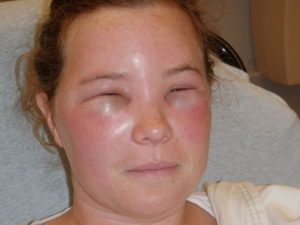
Symptoms
The appearance of signs characteristic of a bee sting after a stinging of the skin is possible from a few seconds to several hours. In this case, the following symptoms are noted:
- sharp pain;
- burning sensation;
- swelling and redness around the wound.
What to do
In case of an unexpected bee sting, you should act quickly, but in no case indulge in panic. The development of complications and consequences in the future depends on the correctness and timeliness of the actions performed.
Immediately after removing the sting, it is necessary to treat the affected area of the body with any antiseptic and apply ice or a cold bandage. If possible, use an antihistamine for external use. This will help relieve puffiness and reduce the burning sensation, itching.
In the event of allergic symptoms to a bite, it is recommended to immediately call an ambulance, which, depending on the patient's condition, will use drugs to relieve spasms, edema, inflammation, or introduce adrenaline in more severe cases.
How to avoid a bee sting
Individuals of the honey bee are aggressive only in exceptional cases. When you are on vacation in the bosom of nature, it is advisable not to attract insects with strong aromas of food, bright clothes, not to stir up their homes. It is advisable to take a first-aid kit with antiseptic and antihistamines when traveling with you. To avoid stings when approaching a bee, do not make sudden movements.
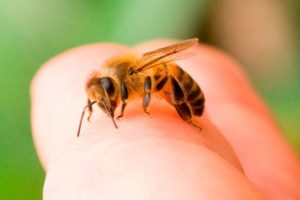
The use of bee venom in medicine
Apitoxin is effectively used in medical practice for the treatment of many diseases. The benefits of bee venom for joints are invaluable. The substance is actively used in diseases of the musculoskeletal system and the nervous system, being the main ingredient in a number of medicines. Ointments, creams, gels with its content have the following beneficial properties:
- resumption of joint activity;
- removal of pain syndrome;
- reduction of puffiness;
- antirheumatic, anti-inflammatory, bactericidal effect;
- bringing metabolism back to normal.
Bee venom treatment
When treating bees, the harm and benefits to human health are based on the characteristics of the state of the body and the presence or absence of an allergy to insect venom.
Apitherapy has long been successfully used in the development of various pathologies, such as:
- rheumatism;
- arthritis;
- vascular disease;
- trophic ulcers;
- inflammation of the peripheral nerves;
- migraine;
- infections;
- furunculosis;
- skin diseases;
- allergy;
- pathology of the visual organs.
Each type of disease has its own treatment options for bees, the number of individuals used and the duration of exposure to apitoxin usually ranges from 4 to 10 minutes.

Bee venom in cosmetology
The area of distribution of bee venom goes beyond medicine. The substance also brings tremendous benefits in the field of cosmetology and is widely used as an effective skin care product. The main properties of bee venom are:
- moisturizing;
- enrichment with useful substances;
- strengthening of blood vessels;
- protection against inflammation.
As a result of the use of cosmetic products based on bee venom, the skin acquires the effect of tightening, firmness and elasticity.
Contraindications to bee venom treatment
Despite the indisputable benefits of bee sting, there are still contraindications to the use of bee venom. These include:
- liver disease;
- heart failure;
- diabetes.
Due to the strong toxicity of the substance, in order to avoid harm from a bee sting, treatment with its use should be carried out under medical supervision.
Conclusion
The benefits and harms of a bee sting depend on the individual tolerance of the body to apitoxin. By following the recommendations for performing apitherapy, you can achieve significant improvements in health without harming the body.
A bee sting will benefit the body if treatment with insect venom is performed with caution and under the supervision of a doctor.

